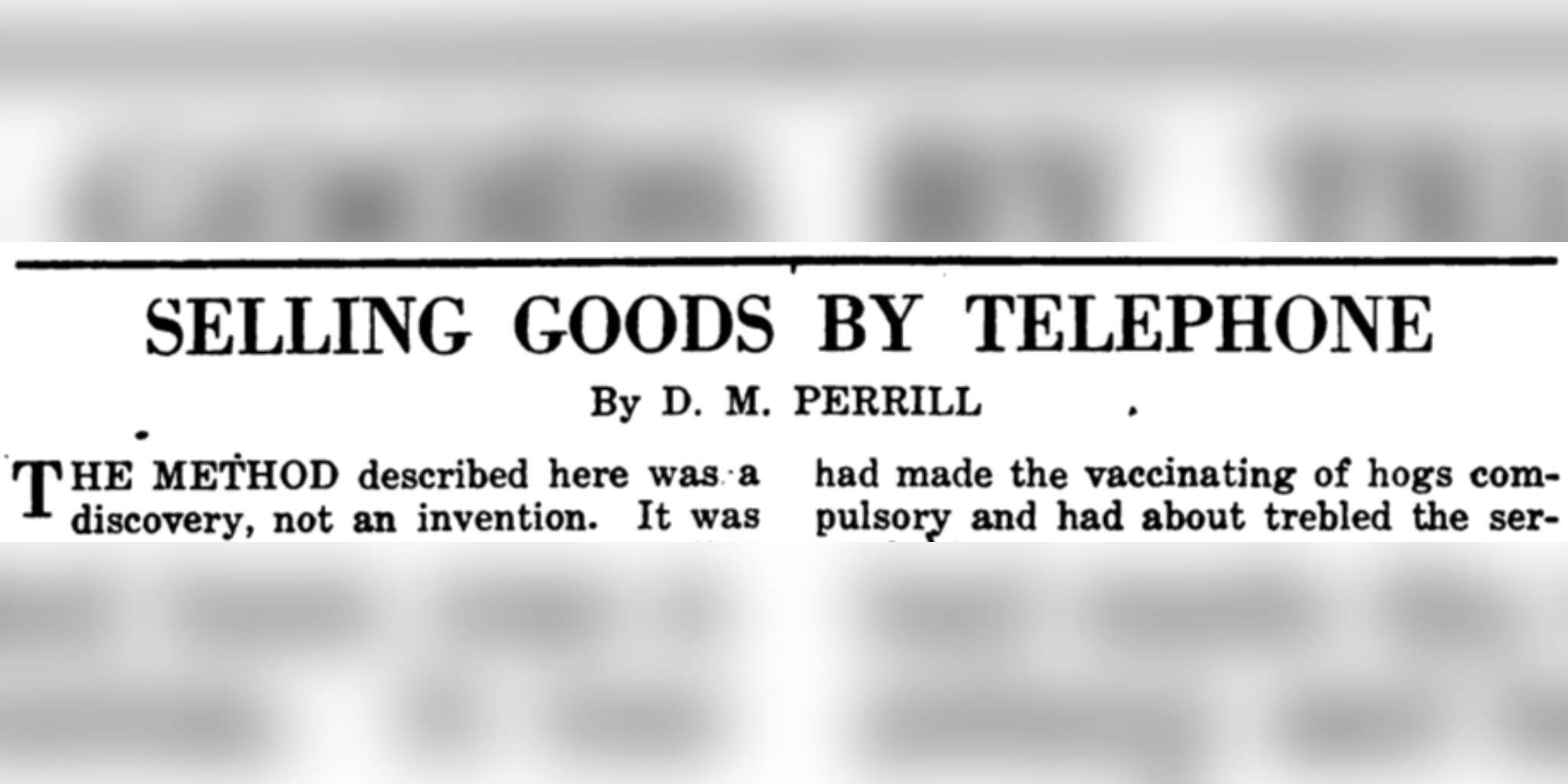The First B2B Cold Calls
Do you remember making your first telephone “cold call”? You probably just did it, right? Very little forethought, other than the fact that it was part of your job. My first selling job required a certain number be made each day, selling overnight shipping.
In 1914, D.M. Perrill did it almost out of desperation.
From my studies, Perrill’s story is the earliest I’ve been able to find of an outbound, cold, business-to-business telephone call – which, by itself, should make this story interesting enough.
But even more ironically, Perrill was working for a ice machine company. Could the first “cold” call using the telephone have been made from a company selling, well, cold?
It may also come to no surprise that those first cold calls employed deception, too.
While Alexander Graham Bell is credited with inventing the telephone in March of 1876, its adoption took many years across homes and businesses. In sales, none of the sales books in my collection discuss telephone selling until the 1950s. Magazines mentioned examples of its use as early as 1912, but relationship concerns, privacy concerns, and the pervasiveness of phones slowed its rise.
That didn’t stop one company from stumbling on the cold outreach practice in August of 1914.
In a 1918 edition of Advertising and Selling Magazine, D.M. Perrill, a salesperson for this ice machine company, tells the story:
He starts by saying, “the method described here was a discovery, not an invention”, and was done almost out of desperation.
“We had just been sent to Kansas City on a long bet to try out a new territory.” Upon arriving, the temperature outside “had been 110 degrees in the shade every day for a week.”
There was a rumor going around town that a serum manufacturing business somewhere in the vicinity was in the market for a new refrigeration machine.
Serum was used to vaccinate livestock. It was harvested from the blood, and needed to be kept cold.
“One of the rules of our firm was that we should never use a telephone if it was possible to see the prospect in person, but there were several of these serum plants making a serum for vaccinating hogs for cholera. They were located in out-of-the-way places all about the city.”
So, instead of taking days to visit them all, they picked up the phone and called them.
Here was their simple script:
“We have just heard a serum plant was about to purchase an ice machine. We thought you were probably the company that was to make the installation.”
They found the one business that was in the market, however, with this approach, even the ones that weren’t in the market suddenly became in-the-market.
Guess what! Because this approach worked so well, they used this approach to focus on serum businesses outside of Kansas City – making up the rumor in each town.
“Inasmuch as the method had given such success in this list, we proceeded to manufacture rumors for every other type of prospect and go through them in the same way. Of course, we never merely called up a concern and asked them if they were going to buy an ice machine. Instead, we wored our inquiry so that, without actually committing ourselves, we let them think that we had a good reason to believe they were actually considering the purchase of the machine.”
It’s the original sin of sales – taking the first great technological gift to the procession, with incredible promises of mutual efficiency for both seller and buyer, the telephone, and immediately used it to stretch to the truth.
I may be biased, but I’m quite confident they could have found the same results without lying.
During those first calls, why wouldn’t they have been able to say, “We understand that a serum plant is purchasing an ice machine, given the temperatures and the requirements surrounding this type of product. However, we weren’t provided the name of the organization – so we’re starting with you.”
Transparency and truth for the win.

I’m a sales keynote speaker (CSP®) who also teaches revenue organizations how to leverage transparency and decision science to maximize their revenue capacity. It’s what I do…teach sellers, their leaders, well…entire revenue organizations how we as human beings make decisions, then how to use that knowledge for good (not evil) in their messaging (informal and formal), negotiations, and revenue leadership. I wrote a book Book Authority listed as the 6th best sales book of all time (𝘛𝘩𝘦 𝘛𝘳𝘢𝘯𝘴𝘱𝘢𝘳𝘦𝘯𝘤𝘺 𝘚𝘢𝘭𝘦), and a second award-winning book (𝘛𝘩𝘦 𝘛𝘳𝘢𝘯𝘴𝘱𝘢𝘳𝘦𝘯𝘵 𝘚𝘢𝘭𝘦𝘴 𝘓𝘦𝘢𝘥𝘦𝘳).
Reach out if you want to discuss The Transparency Sale sales methodology, or really…anything else (sales kickoffs, workshops, keynotes, the economy, history, etc.)! Email info@toddcaponi.com or call 847-999-0420.
Sign up for the newsletter for more of my nonsense in your inbox every other week, with some sales history sprinkled on top…Sign Up – The Transparent Newsletter





0 Comments